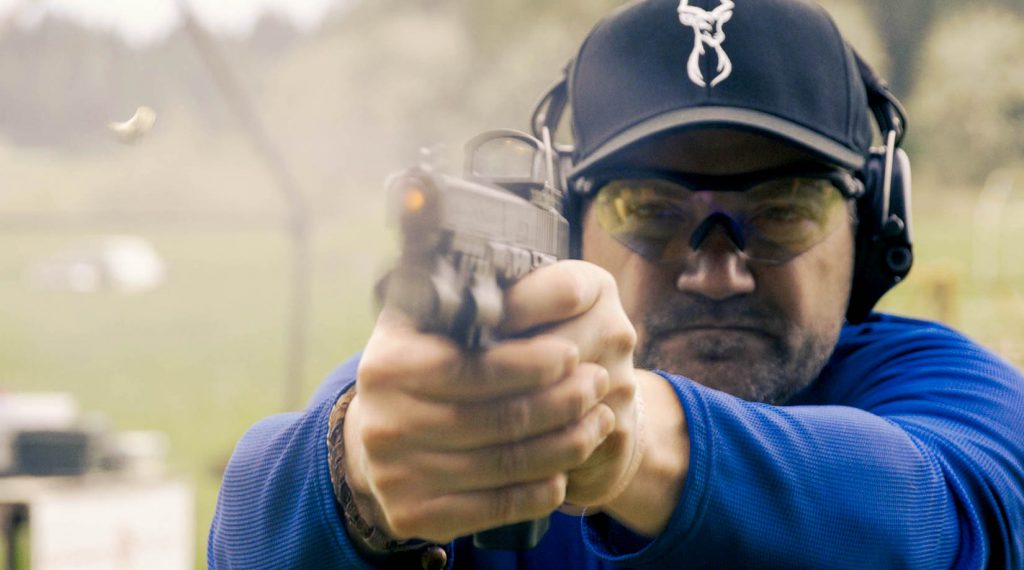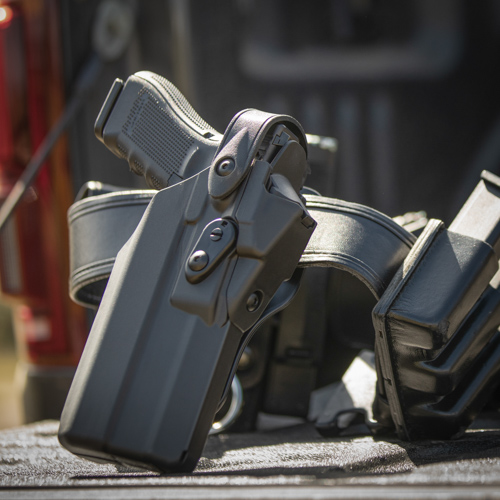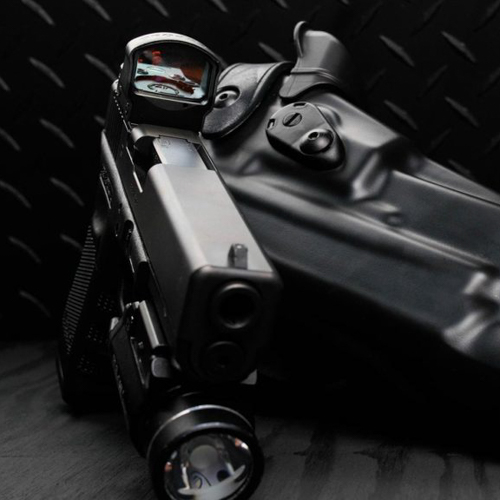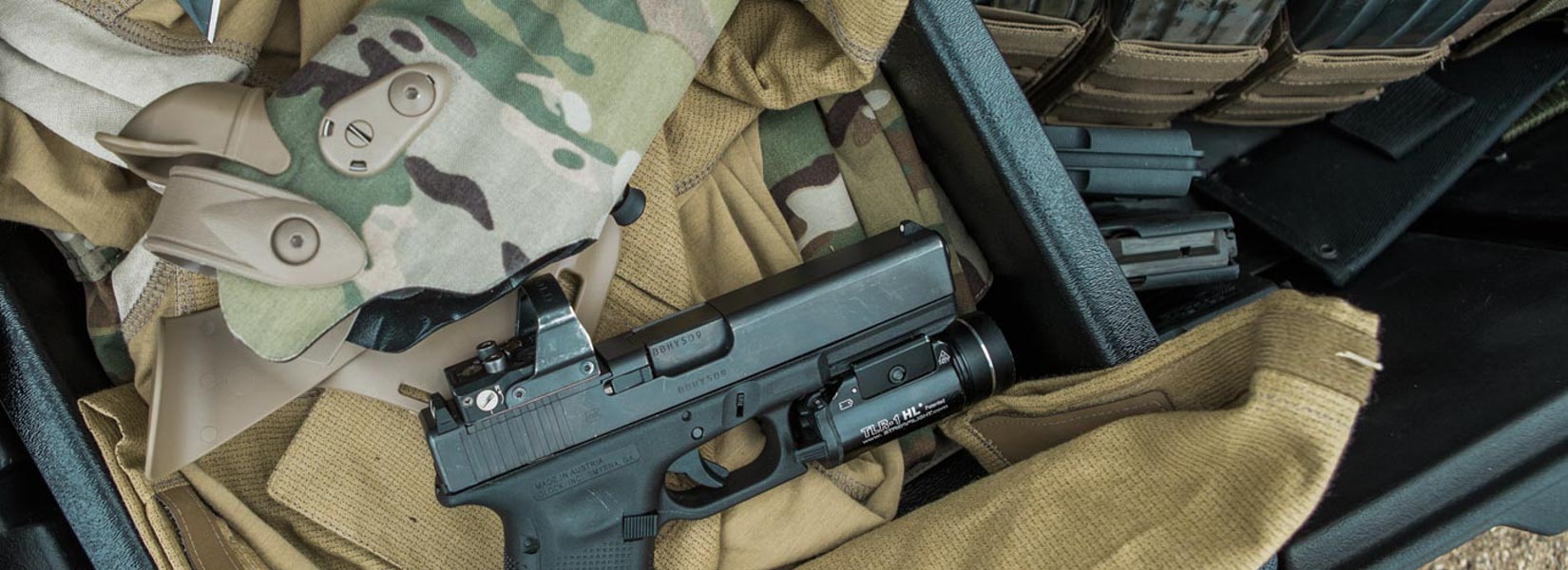What is a red dot sight and how does it work?
Red dot sight (RDS) technology, also known as red dot optics, are gun sights that allow shooters quick and accurate target acquisition. Used for competitive shooting, hunting, and in law enforcement and military applications, the use of RDS has grown considerably as markets shift away from traditional handgun iron sights. Learn more about sighting systems including iron sights, lasers and optics →
The technology uses a red LED (light emitting diode) and non-magnifying spherical mirror to create an illuminated reticle, or red dot, that remains in alignment with the firearm that the sight is attached to. There are many different types of red dot sights. For the purposes of this article, red dot sight technology refers to slide mounted optics which are compatible with Safariland RDS holsters. With slide mounted optics, they are usually set up to work with suppressor height sights to allow for co-witness with backup iron sights.

Red dot sights differ from iron sights in that they allow the shooter to keep both eyes open to focus on the target. The red dot does not need to be centered in the sight, but simply needs to be placed on the target. The use of slide-mounted optics took off after years of use in competitive shooting. Law enforcement and military users found that using this type of sight system reduced teaching and training time for new recruits considerably, as well as dramatically improving accuracy in all users.
The red dot can only be seen through the sight and not from the other side of the shooter. RDS should not be confused with lasers, which project a dot onto the target, or scopes (an optic with magnification).
Red dot optics can be mounted on top of the pistol slide using a mounting plate or a slide cut for different optic manufacturer patterns. The mounting plate is installed in place of the rear sight, and the optic directly mounted to the plate.
Alternatively, cuts can be machined into the slide itself, and the optics mounted directly to the slide, often in front of the rear iron sights. This type of mounting (in rear sight or rear dovetail mounting) is not as common.
How holsters protect optics
The Safariland RDS series holsters are both specifically designed to fit firearms with red dot sights, and to protect the solid glass lens from debris and potential damage. RDS holsters prevent mud and water from accessing the red dot sight cavity, thus keeping the RDS glass clean and free from scratches.

The evolution of Safariland RDS holsters
The first generation of the Safariland optic holster was the 6354DO (Docter Optic). This holster was built for military use and had certain attributes for that purpose, such as a Cordura wrap for camo patterns and other tactical colors. More than just an attractive finish, the practical application of the Cordura wrap includes deadening sound and providing for a low IR signature.
The early optic handguns were specialty builds and mounted the optic at the rear of the slide in the rear sight position or behind the BUIS (Backup Iron Sight). At this time, Glock handguns were the first models modified to work with red dot sights as a practical handgun, and thus were the only fits built for the 6354DO. Since that time the use of slide mounted optics has gone mainstream and the optic position has changed to forward mounted on current OEM optic ready handguns. The 6354DO has maintained its original build design and has not been updated to work with the dual slide release Glock models or forward mounted optics on newer models that are out today. For example, the 6354DO model will not fit the forward mounted Glock Gen5 MOS, without modifying the holster.
Now, Safariland offers a wide range of RDS compatible holsters designed for patrol, concealment and tactical/military. Safariland also offers holsters which are not specifically designed for RDS, but will fit a firearm that has red dot sights attached, such as the 5198 model and GLS Pro-Fit model holsters.
All of the Safariland RDS holsters accommodate both red dot sights and lights (holsters are currently being developed for the future that will fit red dot sights only, without a light).
* Safariland® cannot guarantee that the RDS holster series will be compatible with non-factory (Factory Mounted Examples: Glock MOS, M&P CORE, etc.) mounted red dots. Numerous variables including depth of RDS into a slide, use of dovetail, placement on the slide, etc. can all affect the fit of the holster.
threaded barrels and compensators
To understand fit aspects on the RDS optic holsters including lights and optics, the use of muzzle plugs plays a specific role in our holster builds. Muzzle plugs are used to maintain the stability of the weapon with or without a light as well as for retention purposes.
When ordering an RDS holster the models are depth set to the factory OEM length for standard barrels for that particular handgun model. This means that there is no room for threaded barrels or compensators on standard factory models. Check our Optic Will Fit Chart to see the exact specifications for lights, optics, weapon models and barrel lengths.
Supressor height sights
Optic-ready guns come from the manufacturer with suppressor height sights. This style of iron sights is added for the option to co-witness with a slide-mounted optic. Suppressor height sights are also prevalent in firearms with threaded barrels in order to have iron sights above the suppressor or compensator for proper sight alignment.
Safariland RDS Optic holsters are set up to work with suppressor height sights. Typically, the sight track runs from .50″ to .575″ in the 6000 Series RDS Optic holsters. The 7TS RDS models have a clearance of .60″ or 9/16″. For the best holster fit, you want to be under that measurement. Holsters may vary depending on the firearm/optic combination, but this is a good rule of thumb when considering the sight height for sizing.
In non-RDS, duty and tactical holsters, sight height of .375″ or 3/8″ is good, but a sight height of .4375″ or 7/16″ is considered borderline. A borderline height may contact the holster body causing drag when trying to unholster the firearm.
For the 5198 holster, there is .50″ clearance, as these models will work with slide-mounted optics and are often a choice of competitive shooters. The model 557 holster also has a .50″ clearance and works with optic-mounted firearms.
safariland rds holsters

RDS Holsters for Patrol
Safariland offers RDS compatible holsters specifically designed for patrol officers, with Level I or Level III Retention™ technology. The 6390RDS or 7390RDS holster models provide ALS® Level I Retention™ technology. The ALS system automatically secures the firearm once holstered, until the lock is released with the thumb, and the firearm can be drawn straight out of the holster with no twisting needed. An additional measure of protection is provided by the Hood Guard, an external shield over the thumb lever, which covers the release mechanism.
The 6360RDS and 7360RDS holster models offer ALS®/SLS™ Level III Retention™ technology. The SLS rotating hood closure allows for a smoother, single-motion draw, and greater protection against attempted firearm takeaways. Operators simply depress the hood and push forward to release. The 6360RDS and 7360RDS holsters can be upgraded to Level IV Retention™ with the addition of the SLS Sentry. This retention level is not typically used for patrol and general duty, but is more commonly used by corrections.
There are no Level II Retention™ holster models that will fit optics-equipped firearms; however, a second level of retention can be achieved by adding an ALS Guard to the Level I Retention models.
To protect the optics, an RDS hood guard prevents mud, debris and water from contacting the red dot sights, so they remain clean and functional when you draw your firearm. The RDS hood guard is flipped out of the way on the draw, and is available on holsters of all retention levels. On Level I Retention holsters, the optic cover is flipped open during the draw. On Level III Retention holsters, the optic cover is flipped clear when the SLS mechanism is cleared. The optic cover can be easily taken on or off as the shooter desires.
Retention Devices
The ALS device builds upon the SLS™ (Self Locking System), and provides Level I or Level III Retention™. The ALS is often called a thumb release or lever, and it sits to the inside of the body of the holster against the user. The system uses an internal locking mechanism that secures the gun in all directions simply upon re-holstering. To release the firearm from a positive lock, the operator must press the lever back. Once the retention devices are released, the weapon can be drawn straight out of the holster with no twisting or other motion required. The ALS can also be elevated to Level IV Retention™ with the addition of the Sentry. Additionally, holsters with this ergonomic design are completely operable with the thumb, and the straight up draw makes them very instinctive to use yet difficult for an assailant’s attempted takeaway.
The SLS utilizes a rotating hood retention device, which allows for a smoother, single-motion draw and greater protection against attempted weapon takeaways. To unlock the mechanism, the user rotates the hood forward as they obtain the shooting grip, and holds it in the unlocked position, which allows an opening to draw the firearm from the holster. If the user pushes the SLS hood down to the unlocked position and then releases it, the system will re-lock, securing the firearm in the holster. To close, the user simply pulls back on the rotating hood and the SLS self locks. Since there are two separate and distinct motions the SLS provides two levels of security by itself.
The SLS strap has a ridge (a small flat purchase surface) along the inside area next to the operator. The ridge or button must be pushed down and then forward to flip the SLS strap out of the way, thus allowing the gun to be drawn.
The ALS/SLS combination provides an extra measure of security, and offer Level III Retention™. Safariland’s patented ALS locks the firearm into place immediately upon holstering, while the SLS rotating hood and tension device ensure added security.
The ALS Guard provides additional security for select ALS® concealment, tactical, and duty holsters. This device covers the ALS lever to prevent any accidental or unauthorized use. It can be retrofitted onto existing ALS holsters without the SLS System.
The Model 6000 Hood Guard is a uniquely designed accessory providing protection for the SLS holster system. It will adapt to any SLS holster.
The Model 6001 Sentry provides additional security to the SLS holster system. It attaches to any SLS holster and increases the level of retention by one.
The Model 6002 is a combination of the Hood Guard and Sentry. The Hood Guard provides added protection to the SLS holster system while the Sentry increases the retention level by one. It attaches to any SLS holster.

RDS Holsters for Military/Tactical
Safariland RDS holsters retain the same three-hole mounting pattern as standard holsters, so that users can set up their rig with the QLS kit (Quick Locking System), or any standard mounting platform. This configuration allows use of an optic-equipped handgun in both the patrol environment with a standard duty belt, or to quickly transition to a drop leg holster more commonly used with tactical teams, so they can rapidly clear their heavy body armor or tactical vests.

RDS holsters for concealment
For concealment and everyday carry of optics-equipped firearms, Safariland offers the RDS holster models in the 6000 series, which include the 6378RDS and 6367RDS ALS/SLS . In the 7000 series the RDS holster models encompass the 7378RDS and 7367RDS ALS/SLS.
There are also alternative concealment holster options that accommodate red dot sights, but are not part of the Safariland RDS line of holsters. These include open-top design holsters such as the GLS, the 5198 and 557 model holsters which make it possible to accommodate multiple types of red dot optics.





